Muscovite Dehydration Melting in Silica-Undersaturated Systems: A Case Study from Corundum-Bearing Anatectic Rocks in the Dabie Orogen
Abstract
1. Introduction
2. Geological Setting and Samples
2.1. Dabie Orogen
2.2. North Dabie Zone
2.3. Studies Samples
3. Analytical Method
3.1. Whole-Rock Analysis
3.2. Micro-X-ray Fluorescence (μ-XRF) Maps of the Thin Sections
3.3. Mineral Chemistry
4. Petrography and Mineral Chemistry
4.1. Petrography of Leucosomes and Mesosomes
4.2. Mineral Chemistry
5. Discussion
5.1. Anatectic Origin of Corundum
5.2. Reaction Microstructures and Petrogenetic Grid
5.3. P-T Pseudosection Modelling and P-T Evolution
5.4. White Mica Decompression Melting in the NDZ
6. Conclusions
Author Contributions
Funding
Acknowledgments
Conflicts of Interest
References
- Korsakov, A.V.; Hermann, J. Silicate and carbonate melt inclusions associated with diamonds in deeply subducted carbonate rocks. Earth Planet. Sci. Lett. 2006, 241, 104–118. [Google Scholar] [CrossRef]
- Labrousse, L.; Duretz, T.; Gerya, T. H2O-fluid-saturated melting of subducted continental crust facilitates exhumation of ultrahigh-pressure rocks in continental subduction zones. Earth Planet Sci. Lett. 2015, 428, 151–161. [Google Scholar] [CrossRef]
- Stepanov, A.S.; Hermann, J.; Korsakov, A.V.; Rubatto, D. Geochemistry of ultrahigh-pressure anatexis: Fractionation of elements in the Kokchetav gneisses during melting at diamond-facies conditions. Contrib. Mineral. Petrol. 2014, 167, 1002–1263. [Google Scholar] [CrossRef]
- Liu, Y.C.; Deng, L.P.; Gu, X.F. Multistage exhumation and partial melting of high-Tultrahigh-pressure metamorphic rocks in continental subduction-collision zones. Sci. China Earth Sci. 2015, 58, 1084–1099. [Google Scholar] [CrossRef]
- Deng, L.P.; Liu, Y.C.; Gu, X.F.; Groppo, C.; Rolfo, F. Partial melting of ultrahigh-pressure metamorphic rocks at convergent continental margins: Evidences, melt compositions and physical effects. Geosci. Front. 2018, 9, 1229–1242. [Google Scholar] [CrossRef]
- Ferrero, S.; Wunder, B.; Walczak, K.; O’Brien, P.J.; Ziemann, M.A. Preserved near ultrahigh-pressure melt from continental crust subducted to mantle depths. Geology 2015, 43, 447–450. [Google Scholar] [CrossRef]
- Hermann, J.; Green, D.H. Experimental constraints on high pressure melting in subducted crust. Earth Planet Sci. Lett. 2001, 188, 149–168. [Google Scholar] [CrossRef]
- Vanderhaeghe, O.; Teyssier, C. Partial melting and flow of orogens. Tectonophysics 2001, 342, 451–472. [Google Scholar] [CrossRef]
- Visonà, D.; Lombardo, B. Two-mica and tourmaline leucogranites from the Everest-Makalu region (Nepal-Tibet). Himalayan leucogranite genesis by isobaric heating? Lithos 2002, 62, 125–150. [Google Scholar] [CrossRef]
- Schmidt, M.W.; Vielzeuf, D.; Auzanneau, E. Melting and dissolution of subducting crust at high pressures: The key role of white mica. Earth Planet Sci. Lett. 2004, 228, 65–84. [Google Scholar] [CrossRef]
- Whitney, D.L.; Teyssier, C.; Fayon, A.K. Isothermal decompression, partial melting and exhumation of deep continental crust. In Vertical Coupling and Decoupling in the Lithosphere; Grocott, J., McCaffrey, K.J.W., Taylor, G., Tikoff, B., Eds.; The Geological Society: London, UK, 2004; Volume 227, pp. 313–326. [Google Scholar] [CrossRef]
- Auzanneau, E.; Vielzeuf, D.; Schmidt, M.W. Experimental evidence of decompression melting during exhumation of subducted continental crust. Contrib. Mineral. Petrol. 2006, 152, 125–148. [Google Scholar] [CrossRef]
- Brown, M. Melting of the continental crust during orogenesis: The thermal, rheological, and compositional consequences of melt transport from lower to upper continental crust. Can. J. Earth Sci. 2010, 47, 655–694. [Google Scholar] [CrossRef]
- Groppo, C.; Rolfo, F.; Indares, A. Partial Melting in the Higher Himalayan crystallines of Eastern Nepal: The effect of decompression and implications for the ′channel flow′ model. J. Petrol. 2012, 53, 1057–1088. [Google Scholar] [CrossRef]
- Vielzeuf, D.; Holloway, J.R. Experimental-determination of the fluid-absent melting relations in the pelitic system—Consequences for crustal differentiation. Contrib. Mineral. Petrol. 1988, 98, 257–276. [Google Scholar] [CrossRef]
- Mogk, D.W. Ductile shearing and migmatization at mid-crustal levels in an Archaean high-grade gneiss belt, northern Gallatin Range, Montana, USA. J. Metamorph. Geol. 1992, 10, 427–438. [Google Scholar] [CrossRef]
- Stevens, G.; Clemens, J. Fluid-absent melting and the roles of fluids in the lithosphere: A slanted summary? Chem. Geol. 1993, 108, 1–17. [Google Scholar] [CrossRef]
- Sawyer, E.W. Migmatites formed by water-fluxed partial melting of a leucogranodiorite protolith: Microstructures in the residual rocks and source of the fluid. Lithos 2010, 116, 273–286. [Google Scholar] [CrossRef]
- Weinberg, R.F.; Hasalová, P. Water-fluxed melting of the continental crust: A review. Lithos 2015, 212, 158–188. [Google Scholar] [CrossRef]
- Brown, M. Crustal melting and melt extraction, ascent and emplacement in orogens: Mechanisms and consequences. J. Geol. Soc. 2007, 164, 709–730. [Google Scholar] [CrossRef]
- Dyck, B.; Waters, D.J.; St-Onge, M.R.; Searle, M.P. Muscovite dehydration melting: Reaction mechanisms, microstructures, and implications for anatexis. J. Metamorph. Geol. 2019. [Google Scholar] [CrossRef]
- Raith, M.M.; Sengupta, P.; Kooijman, E.; Upadhyay, D.; Srikantappa, C. Corundum-leucosome-bearing aluminous gneiss from Ayyarmalai, Southern Granulite Terrain, India: A textbook example of vapor phase-absent muscovite-melting in silica-undersaturated aluminous rocks. Am. Mineral. 2010, 95, 897–907. [Google Scholar] [CrossRef]
- Lasalle, S.; Indares, A. Anatectic record and contrasting P–T paths of aluminous gneisses from the central Grenville Province. J. Metamorph. Geol. 2014, 32, 627–646. [Google Scholar] [CrossRef]
- Breton, N.L.; Thompson, A.B. Fluid-absent (dehydration) melting of biotite in metapelites in the early stages of crustal anatexis. Contrib. Mineral. Petrol. 1988, 99, 226–237. [Google Scholar] [CrossRef]
- Brown, M.; Sawyer, E. Granites, migmatites and residual granulites: Relationships and processes. In Working with Migmatites; Sawyer, E.W., Brown, M., Eds.; Short Course Series; Mineralogical Association of Canada: Québec, QC, Canada, 2008; Volume 38, pp. 97–144. [Google Scholar]
- Grant, J.A. Phase-equilibria in low-pressure partial melting of pelitic rocks. Am. J. Sci. 1985, 285, 409–435. [Google Scholar] [CrossRef]
- Cartwright, I.; Barnicoat, A. The generation of quartz-normative melts and corundum-bearing restites by crustal anatexis: Petrogenetic modelling based on an example from the Lewisian of North-West Scotland. J. Metamorph. Geol. 1986, 4, 79–99. [Google Scholar] [CrossRef]
- Pattison, D.; Harte, B. Petrography and mineral chemistry of pelites. In Equilibrium and Kinetics in Contact Metamorphism; Springer: Berlin/Heidelberg, Germany, 1991; pp. 135–179. [Google Scholar]
- Riesco, M.; Stuwe, K.; Reche, J.; Martinez, F.J. Silica depleted melting of pelites. petrogenetic grid and application to the Susqueda Aureole, Spain. J. Metamorph. Geol. 2004, 22, 475–494. [Google Scholar] [CrossRef]
- Kelsey, D.E.; White, R.W.; Powell, R. Calculated phase equilibria in K2O-FeO-MgO-Al2O3-SiO2-H2O for silica-undersaturated sapphire-bearing mineral assemblages. J. Metamorph. Geol. 2005, 23, 217–239. [Google Scholar] [CrossRef]
- Kelsey, D.E. On ultrahigh-temperature crustal metamorphism. Gondwana Res. 2008, 13, 1–29. [Google Scholar] [CrossRef]
- Dorfler, K.M.; Caddick, M.J.; Tracy, R.J. Thermodynamic modeling of crustal melting using xenolith analogs from the cortlandt complex, New York, USA. J. Petrol. 2015, 56, 389–408. [Google Scholar] [CrossRef]
- Guevara, V.; Caddick, M. Shooting at a moving target: Phase equilibria modelling of high-temperature metamorphism. J. Metamorph. Geol. 2016, 34, 209–235. [Google Scholar] [CrossRef]
- Keller, D.S.; Ague, J.J. High-pressure granulite facies metamorphism (similar to 1.8 GPa) revealed in silica-undersaturated garnet-spinel-corundum gneiss, Central Maine Terrane, Connecticut, USA. Am. Mineral. 2018, 103, 1851–1868. [Google Scholar] [CrossRef]
- Giuliani, G.; Ohnenstetter, D.; Fallick, A.; Groat, L.; Fagan, A.J. The geology and genesis of gem corundum deposits. In Geology of Gem Deposits; Groat, L.A., Ed.; Mineralogical Association of Canada: Tucson, AZ, USA, 2014; pp. 29–112. [Google Scholar]
- Simonet, C.; Fritsch, E.; Lasnier, B. A classification of gem corundum deposits aimed towards gem exploration. Ore. Geol. Rev. 2008, 34, 127–133. [Google Scholar] [CrossRef]
- Bottrill, R.S. A corundum-quartz assemblage in altered volcanic rocks, Bond Range, Tasmania. Mineral. Mag. 1998, 62, 325–332. [Google Scholar] [CrossRef]
- Zhang, Z.M.; Ding, H.X.; Dong, X.; Tian, Z.L.; Mu, H.C.; Li, M.M.; Qin, S.K.; Niu, Z.X.; Zhang, N. The eocene corundum-bearing rocks in the gangdese arc, South Tibet: Implications for tectonic evolution of the Himalayan orogen. Geosci. Front. 2018, 9, 1337–1354. [Google Scholar] [CrossRef]
- Sorokina, E.S.; Rassomakhin, M.A.; Nikandrov, S.N.; Karampelas, S.; Kononkova, N.N.; Nikolaev, A.G.; Anosova, M.O.; Somsikova, A.V.; Kostitsyn, Y.A.; Kotlyarov, V.A. Origin of blue sapphire in newly discovered spinel–chlorite–muscovite rocks within meta-ultramafites of Ilmen Mountains, South Urals of Russia: Evidence from mineralogy, geochemistry, Rb-Sr and Sm-Nd isotopic data. Minerals 2019, 9, 36. [Google Scholar] [CrossRef]
- Riesco, M.; Stuwe, K.; Reche, J. Formation of corundum in metapelites around ultramafic bodies. An example from the Saualpe region, Eastern Alps. Mineral. Petrol. 2005, 83, 1–25. [Google Scholar] [CrossRef]
- Yakymchuk, C.; Szilas, K. Corundum formation by metasomatic reactions in Archean metapelite, SW Greenland: Exploration vectors for ruby deposits within high-grade greenstone belts. Geosci. Front. 2018, 9, 727–749. [Google Scholar] [CrossRef]
- Voudouris, P.; Mavrogonatos, C.; Graham, I.; Giuliani, G.; Melfos, V.; Karampelas, S.; Karantoni, V.; Wang, K.; Tarantola, A.; Zaw, K.; et al. Gem corundum deposits of Greece: Geology, mineralogy and genesis. Minerals 2019, 9, 49. [Google Scholar] [CrossRef]
- Palke, A.C.; Renfro, N.D.; Berg, R.B. Melt inclusions in alluvial sapphires from Montana, USA: Formation of sapphires as a restitic component of lower crustal melting? Lithos 2017, 278–281, 43–53. [Google Scholar] [CrossRef]
- Kullerud, K.R.; Nasipuri, P.; Ravna, E.J.K.; Selbekk, R.S. Formation of corundum megacrysts during H2O-saturated incongruent melting of feldspar: P–T pseudosection-based modelling from the Skattøra migmatite complex, North Norwegian Caledonides. Contrib. Mineral. Petrol. 2012, 164, 627–641. [Google Scholar] [CrossRef]
- Li, S.G.; Xiao, Y.L.; Liou, D.L.; Chen, Y.Z.; Ge, N.J.; Zhang, Z.Q.; Sun, S.S.; Cong, B.L.; Zhang, R.Y.; Hart, S.R. Collision of the North China and yangtse blocks and formation of coesite-bearing eclogites: Timing and processes. Chem. Geol. 1993, 109, 89–111. [Google Scholar] [CrossRef]
- Xu, S.T.; Wen, S.; Yican, L.; Laili, J.; Shouyuan, J.; Okay, A.I.; Sengor, A.M. Diamond from the dabie shan metamorphic rocks and its implication for tectonic setting. Science 1992, 256, 80–82. [Google Scholar] [CrossRef]
- Okay, A.I.; Xu, S.T.; Sengor, A.M.C. Coesite from the Dabie Shan eclogites, Central China. Eur. J. Mineral. 1989, 1, 595–598. [Google Scholar] [CrossRef]
- Wang, X.M.; Liou, J.G.; Mao, H.K. Coesite-bearing eclogite from the Dabie mountains in central China. Geology 1989, 17, 1085–1088. [Google Scholar] [CrossRef]
- Xu, S.T.; Liu, Y.C.; Chen, G.; Compagnoni, R.; Rolfo, F.; He, M.; Liu, H. New finding of micro-diamonds in eclogites from Dabie-Sulu region in central-eastern China. Sci. Bull. 2003, 48, 988–994. [Google Scholar] [CrossRef]
- Xu, S.T.; Liu, Y.C.; Chen, G.B.; Ji, S.Y.; Ni, P.; Xiao, W.S. Microdiamonds, their classification and tectonic implications for the host eclogites from the Dabie and Su-Lu regions in central eastern China. Mineral. Mag. 2005, 69, 509–520. [Google Scholar] [CrossRef]
- Liu, Y.C.; LI, S.G.; Gu, X.F.; Xu, S.T.; Chen, G.B. Ultrahigh-pressure eclogite transformed from mafic granulite in the Dabie orogen, east-central China. J. Metamorph. Geol. 2007, 25, 975–989. [Google Scholar] [CrossRef]
- Li, Y.; Liu, Y.C.; Yang, Y.; Deng, L.P. New U-Pb Geochronological Constraints on Formation and Evolution of the Susong Complex Zone in the Dabie Orogen. Acta Geol. Sin. Engl. 2017, 91, 1915–1918. [Google Scholar] [CrossRef]
- Liu, Y.C.; Liu, L.-X.; Li, Y.; Gu, X.-F.; Song, B. Zircon U-Pb geochronology and petrogenesis of metabasites from the western Beihuaiyang zone in the Hong’an orogen, central China: Implications for detachment within subducting continental crust at shallow depths. J. Asian Earth Sci. 2017, 145, 74–90. [Google Scholar] [CrossRef]
- Xu, S.T.; Wu, W.P.; Lu, Y.Q.; Wang, D.H. Tectonic setting of the low-grade metamorphic rocks of the Dabie Orogen, central eastern China. J. Struct. Geol. 2012, 37, 134–149. [Google Scholar] [CrossRef]
- Groppo, C.; Rolfo, F.; Liu, Y.C.; Deng, L.P.; Wang, A.D. PT evolution of elusive UHP eclogites from the luotian dome (North Dabie zone, China): How far can the thermodynamic modeling lead us? Lithos 2015, 226, 183–200. [Google Scholar] [CrossRef]
- Li, S.G.; Jagoutz, E.; Chen, Y.Z.; Li, Q.L. Sm-Nd and Rb-Sr isotopic chronology and cooling history of ultrahigh pressure metamorphic rocks and their country rocks at Shuanghe in the Dabie mountains, central China. Geochim. Cosmochim. Acta 2000, 64, 1077–1093. [Google Scholar] [CrossRef]
- Liu, Y.C.; Li, S.G.; Xu, S.T.; Jahn, B.M.; Zheng, Y.F.; Zhang, Z.Q.; Jiang, L.L.; Chen, G.B.; Wu, W.P. Geochemistry and geochronology of eclogites from the northern Dabie Mountains, central China. J. Asian Earth Sci. 2005, 25, 431–443. [Google Scholar] [CrossRef]
- Liu, Y.C.; Gu, X.F.; Rolfo, F.; Chen, Z.Y. Ultrahigh-pressure metamorphism and multistage exhumation of eclogite of the Luotian dome, North Dabie Complex Zone (central China): Evidence from mineral inclusions and decompression textures. J. Asian Earth Sci. 2011, 42, 607–617. [Google Scholar] [CrossRef]
- Okay, A.I. Petrology of a diamond and coesite-bearing metamorphic terrain—Dabie Shan, China. Eur. J. Mineral. 1993, 5, 659–675. [Google Scholar] [CrossRef]
- Rolfo, F.; Compagnoni, R.; Wu, W.; Xu, S. A coherent lithostratigraphic unit in the coesite–eclogite complex of Dabie Shan, China: Geologic and petrologic evidence. Lithos 2004, 73, 71–94. [Google Scholar] [CrossRef]
- Liu, Y.C.; Deng, L.P.; Gu, X.F.; Chiara, G.; Franco, R. Multistage metamorphic evolution and P-T-t Path of high-T eclogite from the North Dabie Complex Zone during continental subduction and exhumation. Acta Geol. Sin. Engl. 2016, 90, 759–760. [Google Scholar] [CrossRef]
- Liu, Y.C.; Li, S. Detachment within subducted continental crust and multi-slice successive exhumation of ultrahigh-pressure metamorphic rocks: Evidence from the Dabie-Sulu orogenic belt. Chin. Sci. Bull. 2008, 53, 3105–3119. [Google Scholar] [CrossRef]
- Liu, Y.C.; Deng, L.P.; Gu, X.F.; Groppo, C.; Rolfo, F. Application of Ti-in-zircon and Zr-in-rutile thermometers to constrain high-temperature metamorphism in eclogites from the Dabie orogen, central China. Gondwana Res. 2015, 27, 410–423. [Google Scholar] [CrossRef]
- Liu, Y.C.; Li, S.G.; Xu, S.T. Zircon Shrimp U–Pb dating for gneisses in northern Dabie high T/P metamorphic zone, central China: Implications for decoupling within subducted continental crust. Lithos 2007, 96, 170–185. [Google Scholar] [CrossRef]
- Liu, Y.C.; Yang, Y.; Li, Y. New constraints on multiple anatexis in the North Dabie complex zone and mountain-root collapse in the Dabie Orogen, central China. Chin. J. Geol. 2019, 54, 664–677. [Google Scholar]
- Wang, J.H.; Sun, M.; Deng, S.X. Geochronological constraints on the timing of migmatization in the Dabie Shan, East-central China. Eur. J. Mineral. 2002, 14, 513–524. [Google Scholar] [CrossRef]
- Wang, S.J.; Li, S.G.; Chen, L.J.; He, Y.S.; An, S.C.; Shen, J. Geochronology and geochemistry of leucosomes in the North Dabie Terrane, East China: Implication for post-UHPM crustal melting during exhumation. Contrib. Mineral. Petrol. 2013, 165, 1009–1029. [Google Scholar] [CrossRef]
- Malaspina, N.; Hermann, J.; Scambelluri, M.; Compagnoni, R. Multistage metasomatism in ultrahigh-pressure mafic rocks from the North Dabie Complex (China). Lithos 2006, 90, 19–42. [Google Scholar] [CrossRef]
- Liu, Y.C.; Gu, X.F.; Li, S.G.; Hou, Z.H.; Song, B. Multistage metamorphic events in granulitized eclogites from the North Dabie complex zone, central China: Evidence from zircon U–Pb age, trace element and mineral inclusion. Lithos 2011, 122, 107–121. [Google Scholar] [CrossRef]
- Deng, L.P.; Liu, Y.C.; Yang, Y.; Groppo, C.; Rolfo, F.; Gu, X.F. Anatexis of high-T eclogites in the Dabie orogen triggered by exhumation and post-orogenic collapse. Eur. J. Mineral. 2019, 31, 889–903. [Google Scholar] [CrossRef]
- Tsai, C.-H.; Liou, J.G. Eclogite-facies relics and inferred ultrahigh-pressure metamorphism in the North Dabie Complex, central-eastern China. Am. Mineral. 2000, 85, 1–8. [Google Scholar] [CrossRef]
- Yang, Y.; Liu, Y.C.; Li, Y.; Groppo, C.; Rolfo, F.; Deng, L.P.; Song, B. Time and petrogenesis of different generations of leucosomes in the North Dabie complex zone, central China: New constraints on multiple episodes of anatexis. unpulished.
- Whitney, D.L.; Evans, B.W. Abbreviations for names of rock-forming minerals. Am. Mineral. 2010, 95, 185–187. [Google Scholar] [CrossRef]
- Stern, R.J.; Tsujimori, T.; Harlow, G.; Groat, L.A. Plate tectonic gemstones. Geology 2013, 41, 723–726. [Google Scholar] [CrossRef]
- Evans, B. Application of a reaction-rate method to the breakdown equilibria of muscovite and muscovite plus quartz. Am. J. Sci. 1965, 263, 647–667. [Google Scholar] [CrossRef]
- Huang, W.L.; Robertson, J.K.; Wyllie, P.J. Melting relations of muscovite to 30 kilobars in the system KAlSi3O8-Al2O3 -H2O. Am. J. Sci. 1973, 273, 415–427. [Google Scholar] [CrossRef]
- Huang, W.L.; Wyllie, P.J. Muscovite dehydration and melting in deep crust and subducted oceanic sediments. Earth Planet Sci. Lett. 1973, 18, 133–136. [Google Scholar] [CrossRef]
- Huang, W.L.; Wyllie, P.J. Melting relations of muscovite with quartz and sanidine in the K2O-Al2O3-SiO2-H2O system to 30 kilobars and an outline of paragonite melting relations. Am. J. Sci. 1974, 274, 378–395. [Google Scholar] [CrossRef]
- Velde, B. Upper stability of muscovite. Am. Mineral. 1966, 51, 924–929. [Google Scholar]
- Newton, R.C.; Manning, C.E. Solubility of corundum in the system Al2O3–SiO2–H2O–NaCl at 800 °C and 10 kbar. Chem. Geol. 2008, 249, 250–261. [Google Scholar] [CrossRef]
- Altherr, R.; Okrusch, M.; Bank, H. Corundum-and kyanite-bearing anatexites from the Precambrian of Tanzania. Lithos 1982, 15, 191–197. [Google Scholar] [CrossRef]
- Powell, R.; Downes, J. Garnet porphyroblast-bearing leucosomes in metapelites: Mechanisms, phase diagrams, and an example from Broken Hill, Australia. In High-Temperature Metamorphism and Crustal Anatexis; Springer: Berlin/Heidelberg, Germany, 1990; pp. 105–123. [Google Scholar]
- Braun, I.; Raith, M.; Kumar, G.R.R. Dehydration—melting phenomena in leptynitic gneisses and the generation of leucogranites: A case study from the kerala khondalite belt, Southern India. J. Petrol. 1996, 37, 1285–1305. [Google Scholar] [CrossRef]
- White, R.W.; Powell, R.; Halpin, J. Spatially-focussed melt formation in aluminous metapelites from Broken Hill, Australia. J. Metamorph. Geol. 2005, 22, 825–845. [Google Scholar] [CrossRef]
- Connolly, J.A.D. Computation of phase equilibria by linear programming: A tool for geodynamic modeling and its application to subduction zone decarbonation. Earth Planet. Sci. Lett. 2005, 236, 524–541. [Google Scholar] [CrossRef]
- Holland, T.J.B.; Powell, R. An improved and extended internally consistent thermodynamic dataset for phases of petrological interest, involving a new equation of state for solids. J. Metamorph. Geol. 2011, 29, 333–383. [Google Scholar] [CrossRef]
- Holland, T.J.B.; Powell, R. An internally consistent thermodynamic data set for phases of petrological interest. J. Metamorph. Geol. 1998, 16, 309–343. [Google Scholar] [CrossRef]
- Kelsey, D.; White, R.; Holland, T.; Powell, R. Calculated phase equilibria in K2O-FeO-MgO-Al2O3-SiO2-H2O for sapphirine-quartz-bearing mineral assemblages. J. Metamorph. Geol. 2004, 22, 559–578. [Google Scholar] [CrossRef]
- White, R.W.; Powell, R.; Holland, T.J.B.; Johnson, T.E.; Green, E.C.R. New mineral activity–composition relations for thermodynamic calculations in metapelitic systems. J. Metamorph. Geol. 2014, 32, 261–286. [Google Scholar] [CrossRef]
- Fuhrman, M.L.; Lindsley, D.H. Ternary-Feldspar modeling and thermometry. Am. Mineral. 1988, 73, 201–215. [Google Scholar]
- White, R.W.; Powell, R.; Clarke, G.L. The interpretation of reaction textures in Fe-rich metapelitic granulites of the Musgrave Block, central Australia: Constraints from mineral equilibria calculations in the system K2O-FeO-MgO-Al2O3-SiO2-H2O-TiO2-Fe2O3. J. Metamorph. Geol. 2002, 20, 41–55. [Google Scholar] [CrossRef]
- White, R.W.; Powell, R.; Holland, T.J.B. Progress relating to calculation of partial melting equilibria for metapelites. J. Metamorph. Geol. 2007, 25, 511–527. [Google Scholar] [CrossRef]
- Groppo, C.; Rolfo, F.; Mosca, P. The cordierite-bearing anatectic rocks of the higher Himalayan crystallines (eastern Nepal): Low-pressure anatexis, melt productivity, melt loss and the preservation of cordierite. J. Metamorph. Geol. 2013, 31, 187–204. [Google Scholar] [CrossRef]
- Spear, F.S.; Kohn, M.J.; Cheney, J.T. P-T paths from anatectic pelites. Contrib. Mineral. Petrol. 1999, 134, 17–32. [Google Scholar] [CrossRef]
- Poli, S.; Schmidt, M.W. The high-pressure stability of zoisite and phase relationships of zoisite-bearing assemblages. Contrib. Mineral. Petrol. 1998, 130, 162–175. [Google Scholar] [CrossRef]
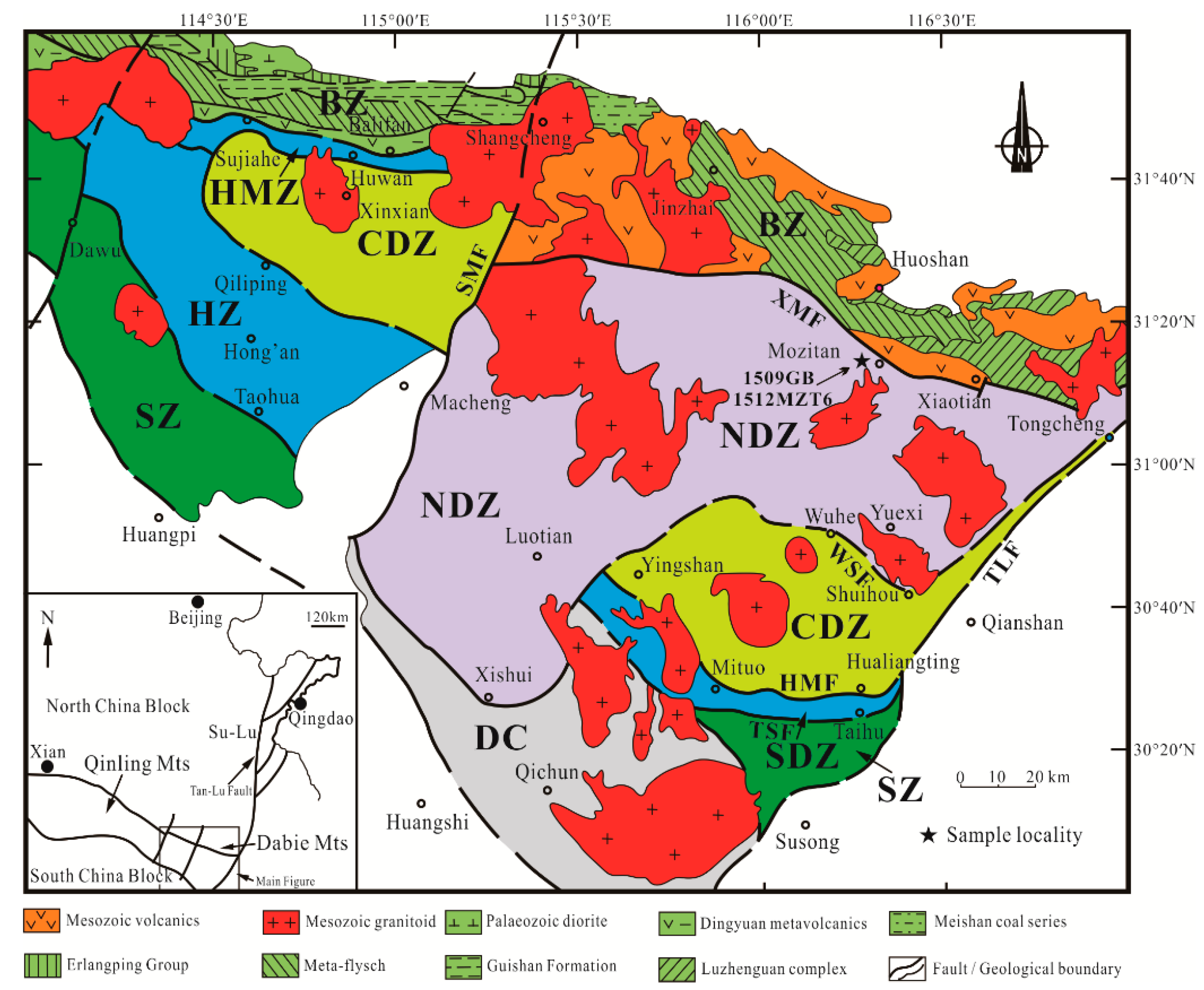
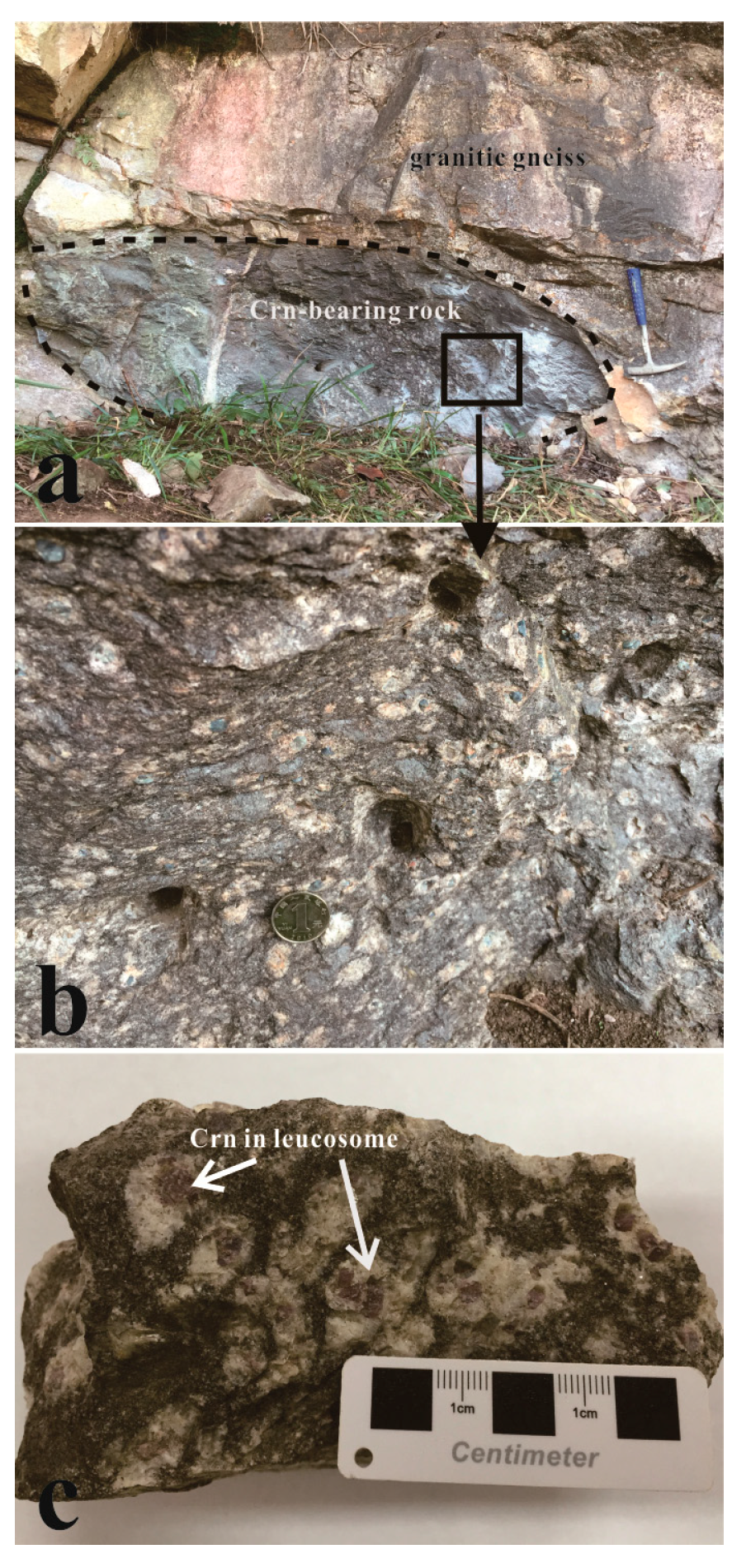
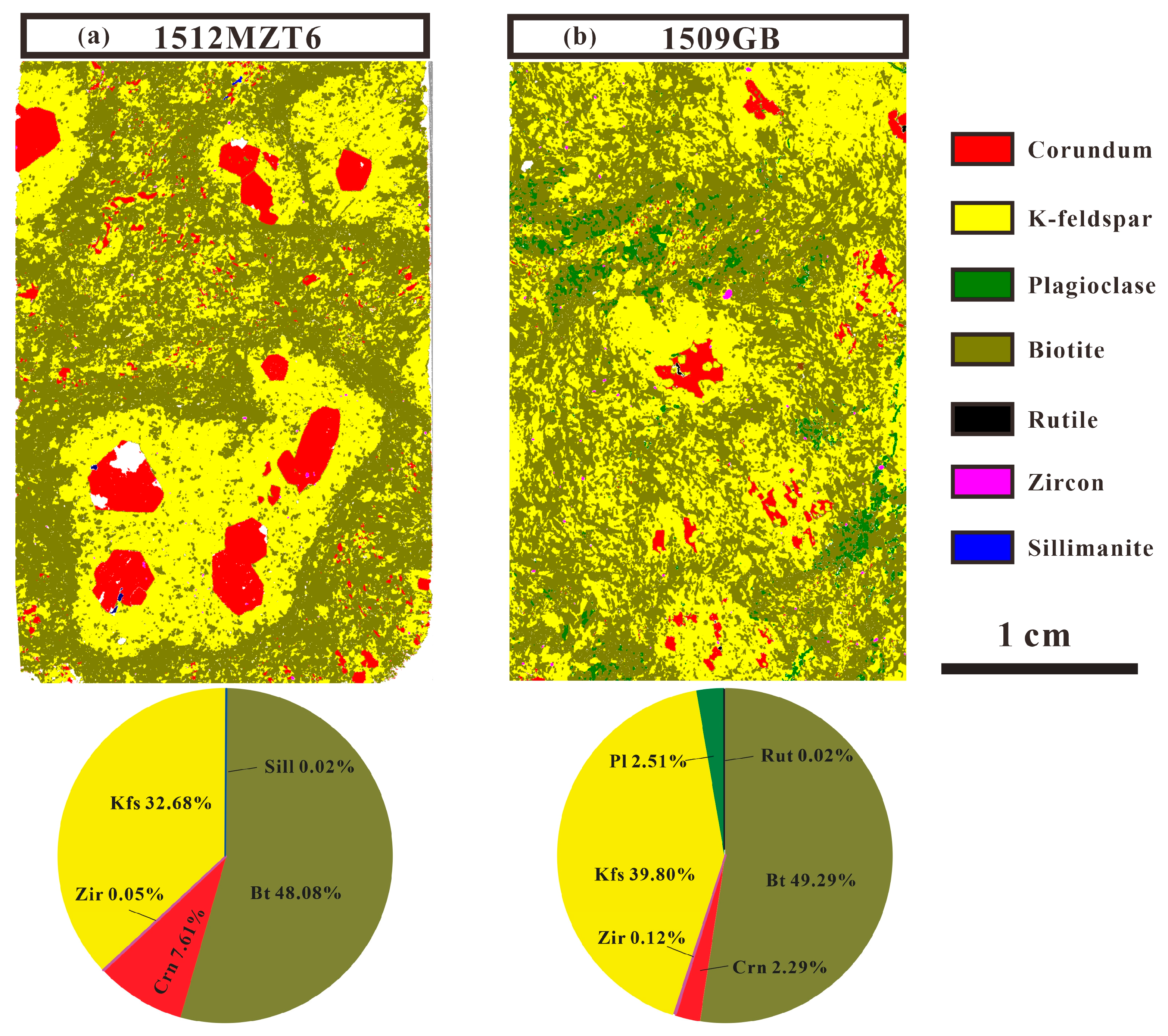
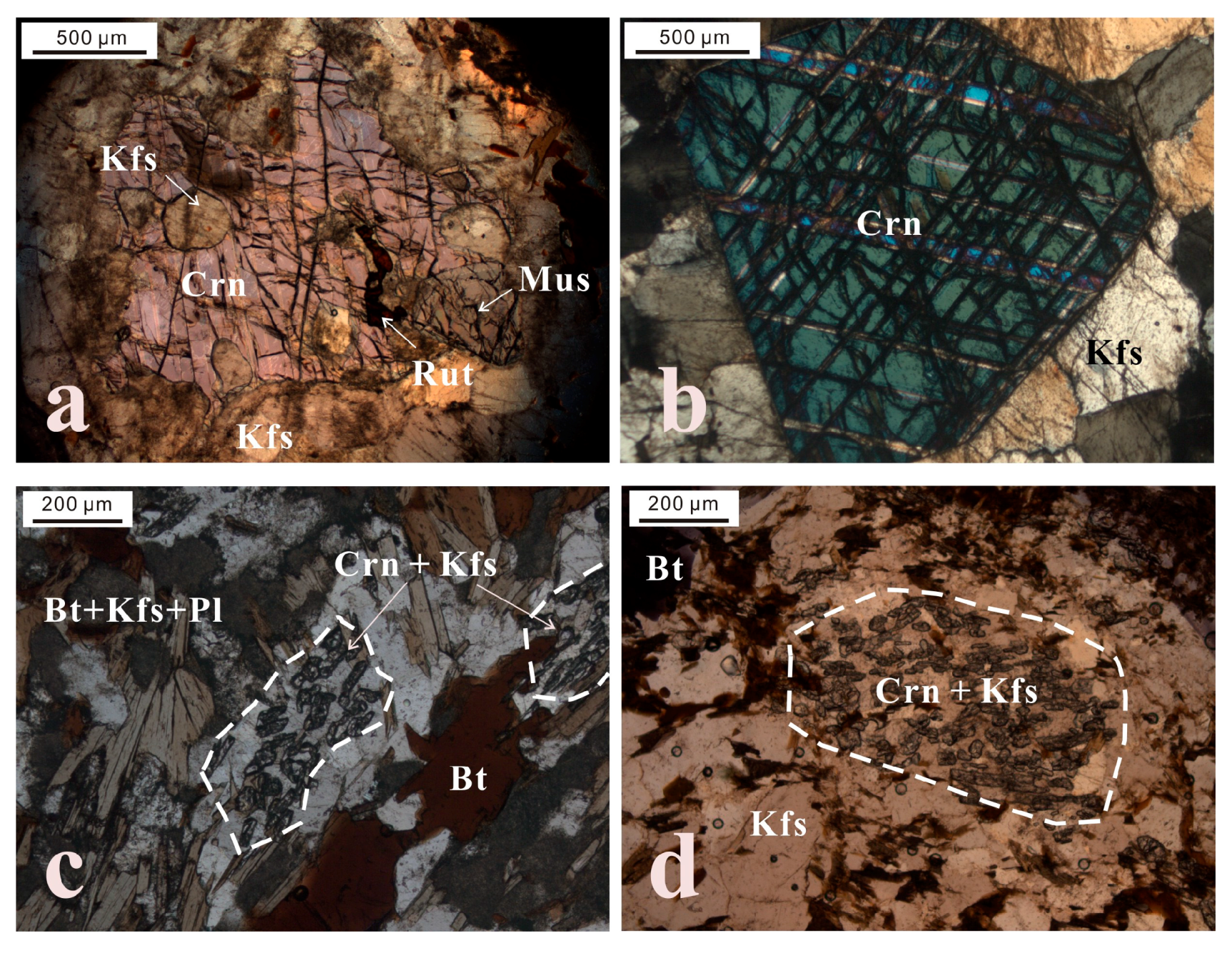
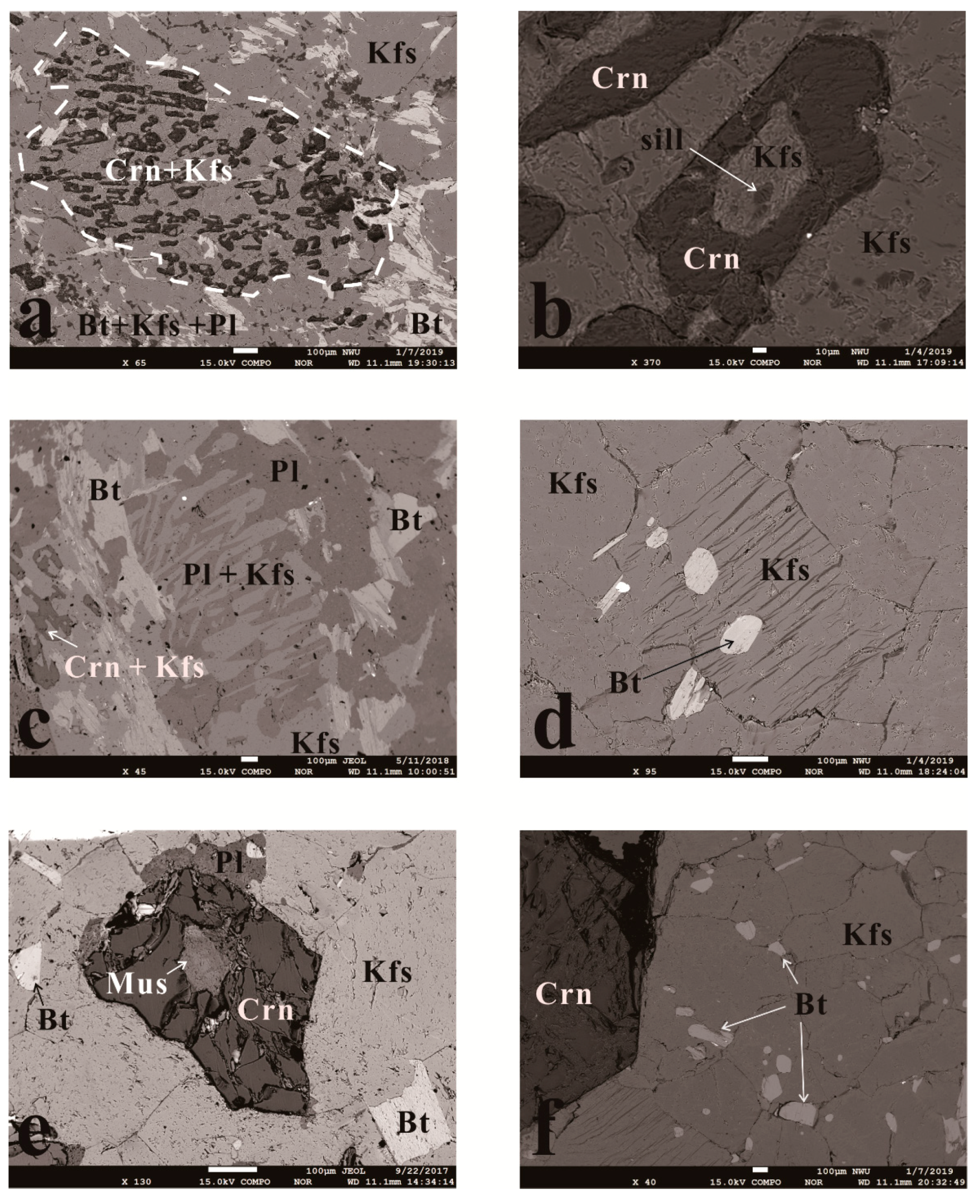
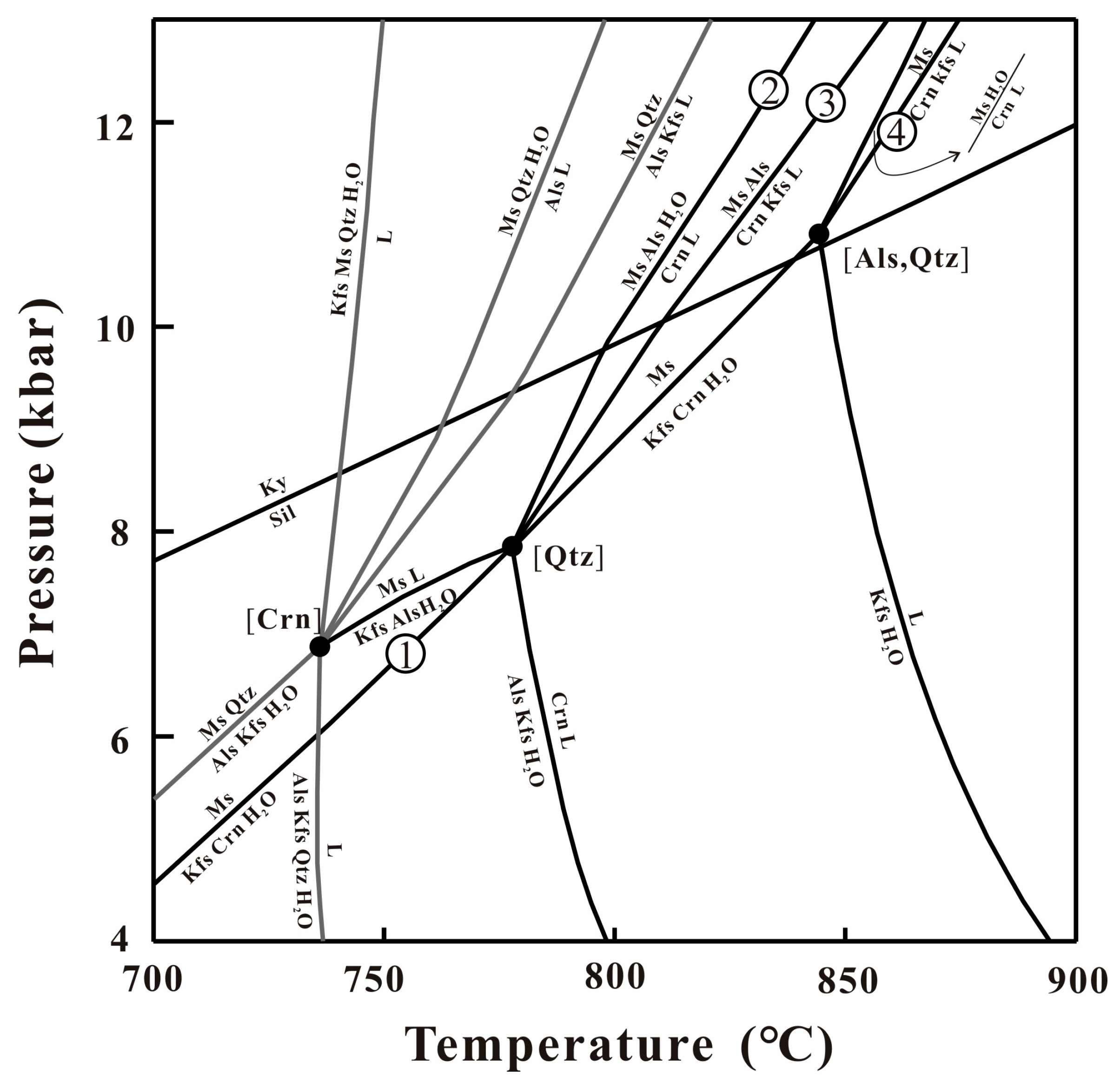
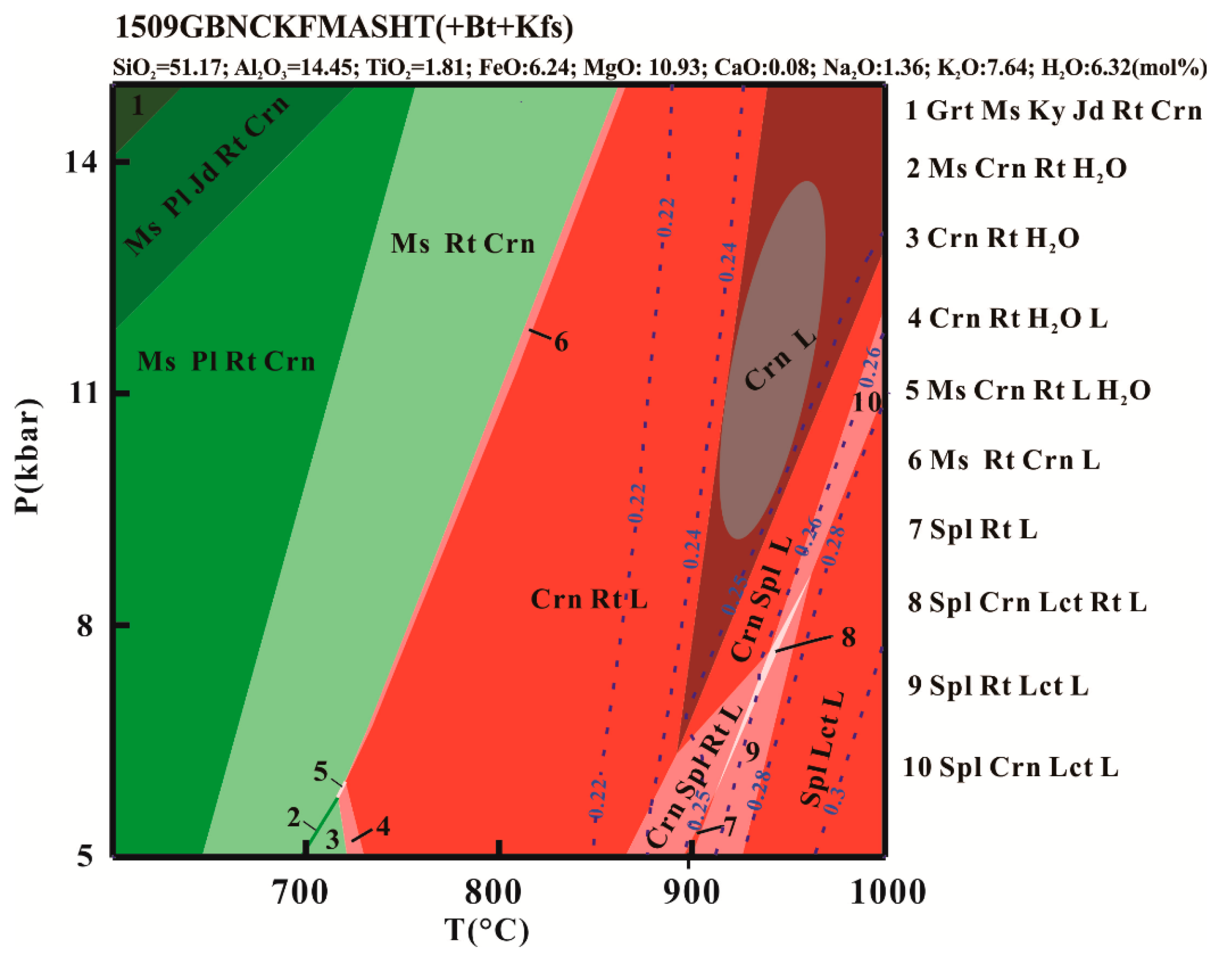
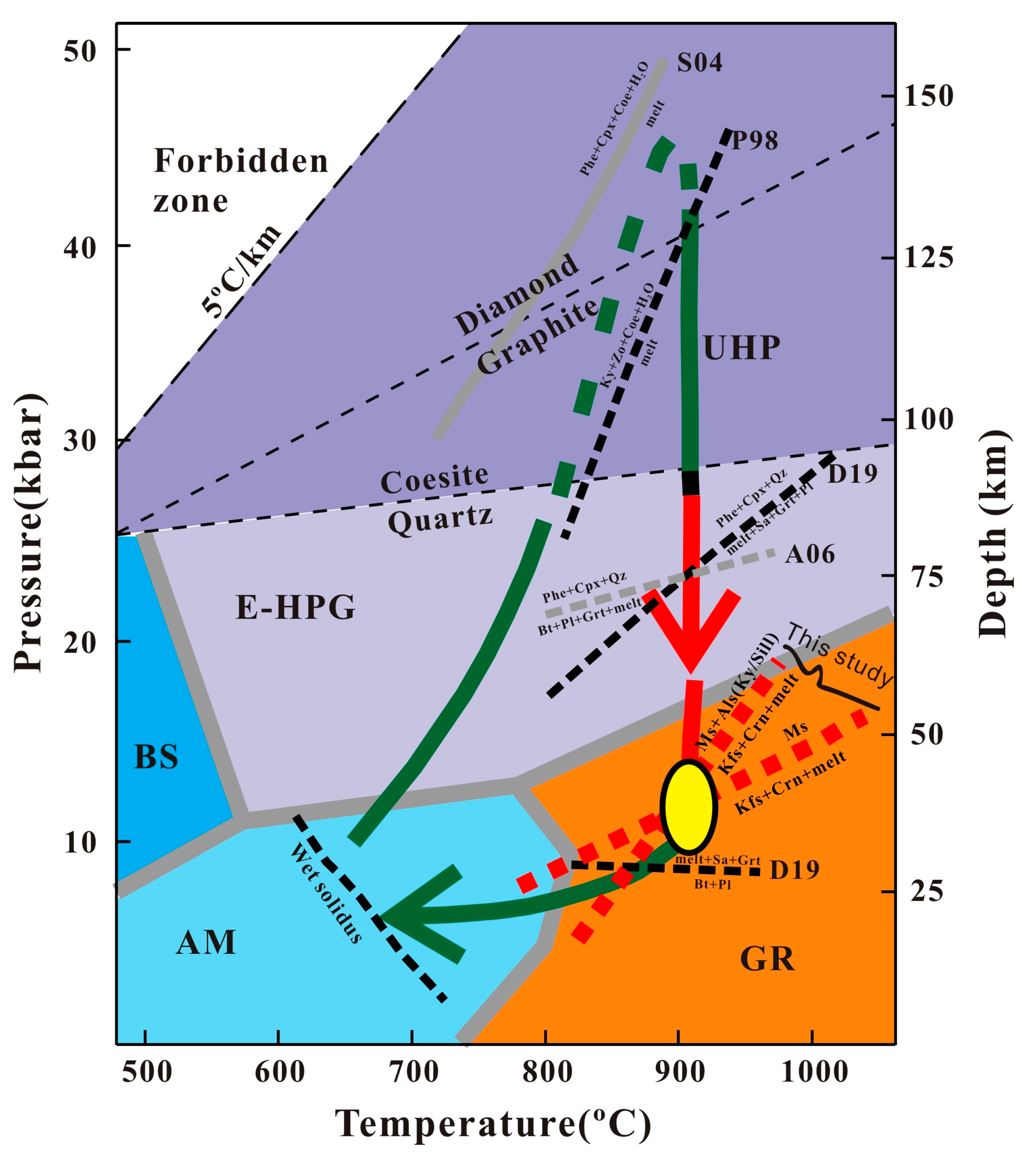
| a | Bulk Composition | b | Modeling Composition | |
|---|---|---|---|---|
| (wt%) | (mol%) | |||
| 1512MZT6 | 1509GB | 1509GB | ||
| SiO2 | 49.89 | 51.72 | SiO2 | 51.17 |
| Al2O3 | 28.62 | 25.98 | Al2O3 | 14.45 |
| TiO2 | 0.81 | 1.04 | TiO2 | 1.81 |
| Fe2O3 | 0.77 | 0.49 | FeO | 6.24 |
| FeO | 3.83 | 2.83 | CaO | 0.08 |
| CaO | 0.21 | 0.40 | MgO | 10.93 |
| MgO | 2.45 | 3.28 | K2O | 7.64 |
| K2O | 9.86 | 9.41 | Na2O | 1.36 |
| Na2O | 1.71 | 2.36 | H2O | 6.32 |
| MnO | 0.03 | 0.03 | Total | 100 |
| P2O5 | 0.01 | 0.01 | ||
| LOI | 1.14 | 1.05 | ||
| Total | 99.33 | 98.59 1 | ||
| Ba (ppm) | 5748 | 12,900 | ||
| Wt % | Sample 1509GB | Sample 1512MZT6 | |||||||||||||||
|---|---|---|---|---|---|---|---|---|---|---|---|---|---|---|---|---|---|
| Mineral | Bt | Crn | Kfs | Pl | Mus | Bt | Crn | Kfs | Pl | Mus | Sill | ||||||
| Location | Lc | Mo | Lc | Mo | Lc | Mo | Mo | Relic | Lc | Mo | Lc | Mo | Lc | Mo | Mo | Relic | Relic |
| SiO2 | 36.01 | 35.52 | 0.04 | 0.99 | 63.72 | 63.76 | 60.93 | 47.45 | 34.36 | 35.02 | 0.00 | 0.09 | 65.32 | 65.28 | 66.36 | 47.48 | 36.12 |
| TiO2 | 4.75 | 3.74 | 0.01 | 0.01 | 0.08 | 0.05 | 0.00 | 0.09 | 3.87 | 3.30 | 0.00 | 0.04 | 0.04 | 0.00 | 0.00 | 0.22 | 0.04 |
| Al2O3 | 19.77 | 19.81 | 99.05 | 98.08 | 19.58 | 18.53 | 23.66 | 35.86 | 19.46 | 19.86 | 98.74 | 97.78 | 18.57 | 18.57 | 20.47 | 37.35 | 62.67 |
| Cr2O3 | 0.02 | 0.11 | 0.12 | 0.22 | 0.05 | 0.00 | 0.01 | 0.07 | 0.06 | 0.01 | 0.03 | 0.00 | 0.02 | 0.10 | 0.00 | 0.07 | 0.00 |
| FeO | 12.90 | 12.63 | 0.39 | 0.41 | 0.00 | 0.00 | 0.02 | 0.43 | 17.31 | 17.09 | 0.76 | 0.73 | 0.02 | 0.01 | 0.06 | 1.19 | 0.63 |
| MnO | 0.10 | 0.09 | 0.02 | 0.01 | 0.00 | 0.00 | 0.01 | 0.00 | 0.15 | 0.08 | 0.02 | 0.00 | 0.00 | 0.00 | 0.06 | 0.04 | 0.04 |
| MgO | 11.24 | 12.49 | 0.00 | 0.02 | 0.00 | 0.02 | 0.01 | 0.04 | 8.79 | 9.49 | 0.00 | 0.00 | 0.00 | 0.00 | 0.02 | 0.15 | 0.00 |
| CaO | 0.03 | 0.00 | 0.02 | 0.00 | 0.15 | 0.08 | 5.28 | 0.02 | 0.00 | 0.00 | 0.03 | 0.06 | 0.09 | 0.04 | 1.14 | 0.01 | 0.02 |
| Na2O | 0.34 | 0.19 | 0.03 | 0.04 | 3.26 | 1.48 | 8.18 | 3.34 | 0.18 | 0.14 | 0.00 | 0.00 | 1.64 | 1.29 | 10.55 | 1.72 | 0.03 |
| K2O | 10.48 | 10.37 | 0.04 | 0.19 | 12.92 | 12.76 | 0.22 | 7.12 | 10.36 | 10.20 | 0.00 | 0.02 | 13.56 | 13.93 | 0.36 | 8.18 | 0.03 |
| Total | 96.08 | 95.05 | 99.71 | 99.95 | 99.83 | 96.86 | 98.32 | 94.43 | 94.61 | 95.39 | 99.58 | 98.70 | 99.47 | 99.38 | 99.03 | 96.41 | 99.58 |
| Formulae | |||||||||||||||||
| O atoms | 11 | 11 | 3 | 3 | 8 | 8 | 8 | 11 | 11 | 11 | 3 | 3 | 8 | 8 | 8 | 11 | 3 |
| Si | 2.405 | 2.36 | 0.00 | 0.03 | 2.93 | 3.00 | 2.75 | 3.135 | 2.365 | 2.37 | 0.00 | 0.00 | 3.00 | 3.01 | 2.94 | 3.065 | 0.98 |
| Ti | 0.24 | 0.185 | 0.00 | 0.00 | 0.00 | 0.00 | 0.00 | 0.005 | 0.2 | 0.17 | 0.00 | 0.00 | 0.00 | 0.00 | 0.00 | 0.01 | 0.00 |
| Al | 1.555 | 1.55 | 2.99 | 2.96 | 1.06 | 1.03 | 1.26 | 2.79 | 1.575 | 1.585 | 2.98 | 2.98 | 1.01 | 1.01 | 1.07 | 2.84 | 2.00 |
| Fe3+ | 0 | 0 | 0.01 | 0.01 | 0.00 | 0.00 | 0.00 | 0 | 0 | 0 | 0.02 | 0.02 | 0.00 | 0.00 | 0.00 | 0 | 0.01 |
| Fe2+ | 0.72 | 0.7 | 0.00 | 0.00 | 0.00 | 0.00 | 0.00 | 0.025 | 0.995 | 0.965 | 0.00 | 0.00 | 0.00 | 0.00 | 0.00 | 0.065 | 0.01 |
| Mg | 1.12 | 1.24 | 0.00 | 0.00 | 0.00 | 0.00 | 0.00 | 0.005 | 0.9 | 0.955 | 0.00 | 0.00 | 0.00 | 0.00 | 0.00 | 0.015 | 0.00 |
| Ca | 0 | 0 | 0.00 | 0.00 | 0.01 | 0.00 | 0.26 | 0 | 0 | 0 | 0.00 | 0.00 | 0.00 | 0.00 | 0.05 | 0 | 0.00 |
| Na | 0.045 | 0.025 | 0.00 | 0.00 | 0.29 | 0.13 | 0.71 | 0.43 | 0.025 | 0.02 | 0.00 | 0.00 | 0.15 | 0.12 | 0.91 | 0.215 | 0.00 |
| K | 0.895 | 0.88 | 0.00 | 0.00 | 0.76 | 0.77 | 0.01 | 0.6 | 0.91 | 0.88 | 0.00 | 0.00 | 0.80 | 0.82 | 0.02 | 0.675 | 0.00 |
| Mn | 0.005 | 0.005 | 0.00 | 0.00 | 0.00 | 0.00 | 0.00 | 0 | 0.01 | 0.005 | 0.00 | 0.00 | 0.00 | 0.00 | 0.00 | 0 | 0.00 |
| XMg | 0.305 | 0.32 | 0 | 0.235 | 0.25 | ||||||||||||
| XAn | 0.01 | 0.00 | 0.26 | 0.00 | 0.00 | 0.06 | |||||||||||
| XAb | 0.28 | 0.15 | 0.73 | 0.15 | 0.12 | 0.92 | |||||||||||
| XOr | 0.72 | 0.85 | 0.01 | 0.84 | 0.87 | 0.02 | |||||||||||
© 2020 by the authors. Licensee MDPI, Basel, Switzerland. This article is an open access article distributed under the terms and conditions of the Creative Commons Attribution (CC BY) license (http://creativecommons.org/licenses/by/4.0/).
Share and Cite
Li, Y.; Yang, Y.; Liu, Y.-C.; Groppo, C.; Rolfo, F. Muscovite Dehydration Melting in Silica-Undersaturated Systems: A Case Study from Corundum-Bearing Anatectic Rocks in the Dabie Orogen. Minerals 2020, 10, 213. https://doi.org/10.3390/min10030213
Li Y, Yang Y, Liu Y-C, Groppo C, Rolfo F. Muscovite Dehydration Melting in Silica-Undersaturated Systems: A Case Study from Corundum-Bearing Anatectic Rocks in the Dabie Orogen. Minerals. 2020; 10(3):213. https://doi.org/10.3390/min10030213
Chicago/Turabian StyleLi, Yang, Yang Yang, Yi-Can Liu, Chiara Groppo, and Franco Rolfo. 2020. "Muscovite Dehydration Melting in Silica-Undersaturated Systems: A Case Study from Corundum-Bearing Anatectic Rocks in the Dabie Orogen" Minerals 10, no. 3: 213. https://doi.org/10.3390/min10030213
APA StyleLi, Y., Yang, Y., Liu, Y.-C., Groppo, C., & Rolfo, F. (2020). Muscovite Dehydration Melting in Silica-Undersaturated Systems: A Case Study from Corundum-Bearing Anatectic Rocks in the Dabie Orogen. Minerals, 10(3), 213. https://doi.org/10.3390/min10030213





